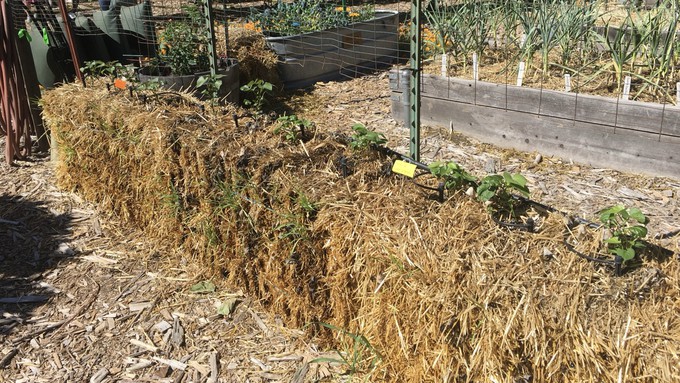
Placer County master gardeners offer free workshop on straw-bale gardening

This collection of sweet potato plants grew in straw bales at the Far Oaks Horticulture Center a few years back. Once the bales are spent at the end of the growing season, they make great compost material, too. Kathy Morrison
Here’s one creative solution to all those gardening drawbacks – straw-bale gardening!
Learn how at a free in-person workshop, offered by the UC Cooperative Extension Master Gardeners of Placer County.
Set for 10:30 a.m. Saturday, March 9, at Loomis Library, “Turn Your Straw into Gold” will cover the basics of straw-bale gardening, which uses a bale of straw soaked in liquid organic fertilizer (such as compost tea) as an instant raised bed.
“Growing your veggies and flowers in easily 'conditioned' straw bales means no soil, no digging, no bending, only a trowel needed,” say the master gardeners.
Once the garden season is over, the straw can be recycled, too, they add. “Your used straw bales make great compost!”
As someone who has tried straw-bale gardening, I found it was a very productive method for difficult spots where nothing else seemed to grow. The bale was elevated enough where there was less bending to tend the plants, and weeds never had a chance to take hold. It was perfect for potatoes and sweet potatoes; when harvest time came, these root vegetables were easy to find.
Straw-bale gardening also works well for eggplants, squash, strawberries, beans, carrots and many other favorites.
No advance registration for this one-hour workshop is needed. Loomis Library is located at 6050 Library Drive, Loomis.
For details and directions: https://pcmg.ucanr.edu/.
Comments
0 comments have been posted.Sacramento Digs Gardening to your inbox.
Sites We Like
Garden Checklist for week of May 5
Survey your garden after the May 4 rainstorm. Heavy rain and gusty winds can break the neck of large flowers such as roses. Also:
* Keep an eye on new transplants or seedlings; they could take a pounding from the rain.
* Watch out for powdery mildew. Warmth following moist conditions can cause this fungal disease to “bloom,” too. If you see a leaf that looks like it’s dusted with powdered sugar, snip it off.
* After the storm, start setting out tomato transplants, but wait on the peppers and eggplants (they want warmer nights). Pinch off any flowers on new transplants to make them concentrate on establishing roots instead of setting premature fruit.
* Trim dead flowers but not leaves from spring-flowering bulbs such as daffodils and tulips. Those leaves gather energy to create next year's flowers. Also, give the bulbs a fertilizer boost after bloom.
* Pinch chrysanthemums back to 12 inches for fall flowers. Cut old stems to the ground.
* Mulch around plants to conserve moisture and control weeds.
* From seed, plant beans, beets, cantaloupes, carrots, corn, cucumbers, melons, pumpkins, radishes and squash.
* Plant onion sets.
* In the flower garden, plant seeds for asters, cosmos, celosia, marigolds, salvia, sunflowers and zinnias. Transplant petunias, zinnias, geraniums and other summer bloomers.
* Plant perennials and dahlia tubers for summer bloom.
* Don’t wait; plant summer bulbs, such as gladiolus and tuberous begonias.
* Harvest cabbage, lettuce, peas and green onions.